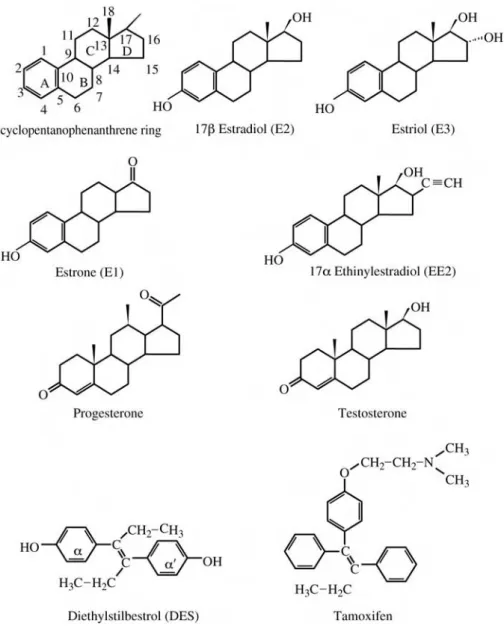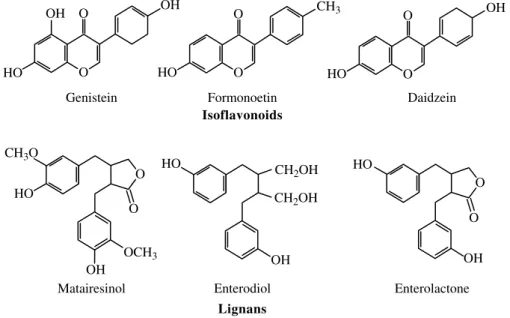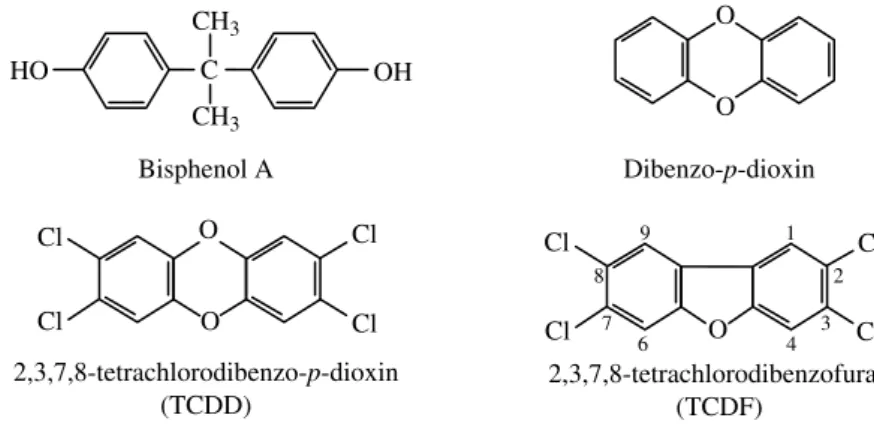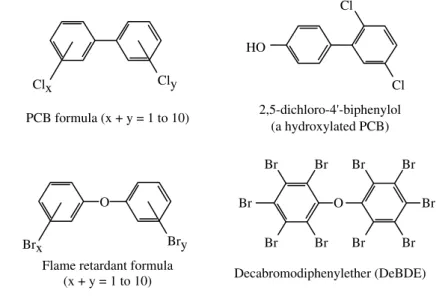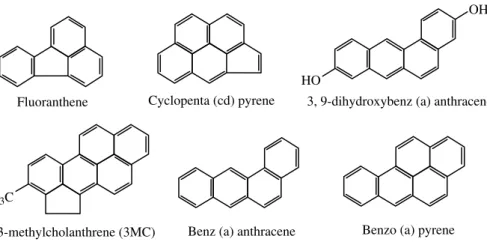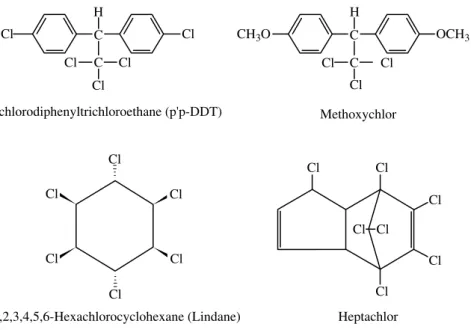Human health concerns are related to the effects on individuals, and the use of the synthetic steroid estrogen diethylstilbestrol (DES) in the 1970s was shown to cause abnormalities in the offspring of women treated with the drug. After a postdoctoral fellowship in the Public Health Engineering Laboratory of the Department of Civil Engineering at Imperial College, he joined the academic staff as a lecturer in 1977.
THE ENDOCRINE SYSTEM
However, when EDCs are present, these mechanisms may not apply, leading to persistence and bioaccumulation of these chemicals in the body. Since agonists and antagonists bind to the same receptor, subtle changes in receptor conformation are taken into account. a) Natural reaction; (b) agonistic effect;
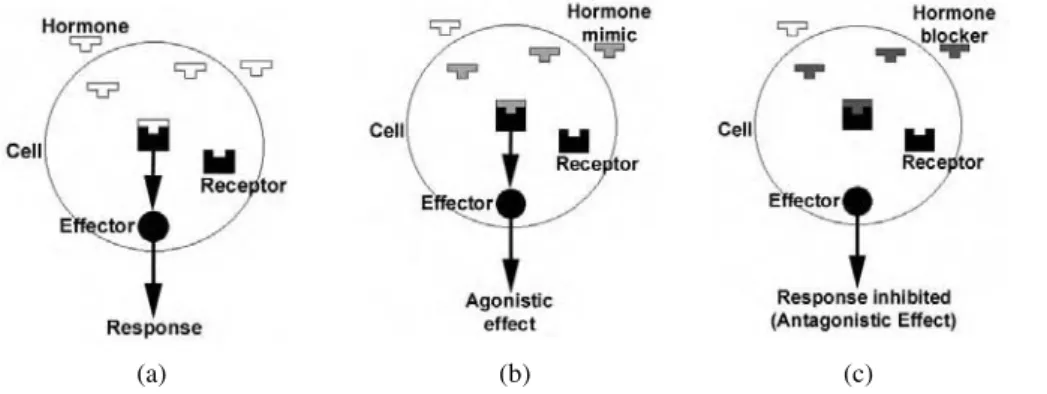
DEFINITIONS
Endocrine disruptors can interfere with the enzymes required to break down hormones in the system. The Environment Agency (UKEA) as endocrine disruptors would be classified as estrogens.78 Therefore, other workers have argued that the term estrogen should be restricted to compounds that can produce estrus, a phase in the sexual cycle characterized by the female's readiness to accept the male.79 According to this definition, only sex steroid hormones (ie, natural hormones produced through biological processes) should be classified as estrogens, while other substances that mimic their estrogenic effect are classified as environmental estrogens.
COMPOUNDS OF INTEREST (CHEMICALS WITH POTENTIALLY ENDOCRINE DISRUPTING POTENTIALLY ENDOCRINE DISRUPTING
As our knowledge of endocrine disruptors increases, so does the list of chemicals that exhibit these endocrine disruptor properties. The European Union (EU) has also produced a report containing a range of substances suspected of affecting the hormonal systems of humans and wildlife.83 The study identified 118 substances that were classified as endocrine disruptors or potential endocrine disruptors.
PROPERTIES OF EDC S .1 P HYSICOCHEMICAL P ROPERTIES.1 PHYSICOCHEMICAL PROPERTIES
O RGANIC O XYGEN C OMPOUNDS .1 Bisphenols.1 Bisphenols
- Dioxins
- Phthalates
- Alkylphenolic Compounds
- Polychlorinated Biphenyls (PCBs)
- Brominated Flame Retardants
- Polycyclic Aromatic Hydrocarbons (PAHs)
The estrogenic potencies of these compounds are on the order of five to six times lower than 17β-estradiol. These compounds are ubiquitous in the environment and have the potential for bioaccumulation and biomagnification.
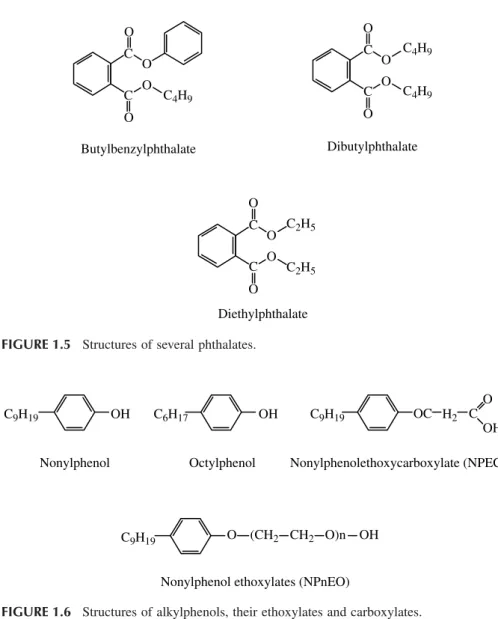
ENVIRONMENTAL EDC PROGRAMS
Metabolites of the compounds are also suspected to be EDCs based on the presence of this 6 Å biophore. Most of this research has already been published66,149–156, as well as two interim reports148,157 on the progress of this program.
REASONS FOR CONCERN
Clark, E.A., Steritt, R.M., and Lester, J.N., The lot of tributaries in the aquatic environment: an introduction, Environ. Murk, A.J., Bosveld, A.T.C., Van den Berg, M., and Brouwer, A., Effects of poly- halogenated aromatic hydrocarbons (PHAHs) on biochemical parameters in chicks of the common tern (Sterna hirundo), Aquat.
W. Birkett
INTRODUCTION
- G ROUNDWATER POLLUTION
The significance of the effect of a particular activity is related to the amounts and types of pollutants released. In addition to the already mentioned types of discharges, pollution of the aquatic environment can be caused by numerous other sources.
SPECIFIC SOURCES RELATING TO ENDOCRINE DISRUPTING CHEMICALS (EDCS)
- S TEROIDS
- Bisphenol A
- Phthalates
- Dioxins
- S URFACTANTS
- Polyaromatic Hydrocarbons (PAHs)
- Polychlorinated Biphenyls (PCBs)
- Brominated Flame Retardants
- P ESTICIDES
A significant portion of these compounds in the environment probably comes from agricultural and biocide applications. PBDE concentrations ranged from non-detectable (n.d.) to 450 μg kg–1 and TBBPA between n.d.
Voulvoulis and M.D. Scrimshaw
IN VITRO ASSAYS
- C OMPETITIVE L IGAND B INDING
- R ECOMBINANT R ECEPTOR –R EPORTER A SSAYS
Assays for estrogenic compounds involve extraction of ER from a cell line such as MCF-717 and subsequent incubation with [3H]17β-estradiol, either with or without the synthetic estrogen diethylstilbestrol (DES) as a control, or test compounds at increasing concentrations. Ligand binding assays have been used to identify estrogenic activity in a variety of compounds, and several workers have compared the effectiveness of assays, for example PAH binding to human estrogen receptor α and β isoforms (hERα and hERβ).20 This work showed that, although the tested compds. In addition to their use in cell proliferation techniques, the MCF-7 strain has been developed and stable or transient transfections of cells have been obtained with recombinant estrogen receptor/reporter genes.
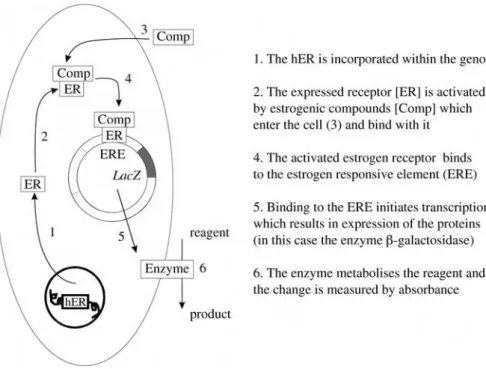
IN VIVO ASSAYS
Such results are reported as potency relative to E2 (which has a value of 100%).36 The results of a series of recombinant tests are summarized in Table 3.3, with an indication of relative activities where possible. As assays become more widely used and strategies testing methods scrutinized for their suitability, a range of issues related to the. Table 3.4 shows the performance of a range of different assay types with respect to estradiol sensitivity.
SCREENING SYSTEMS
The EPA will publish a proposed list of chemicals for the first phase of the review about one year before the date the review is supposed to begin. Such a timescale since the original 1996 legislation reflects the complexity surrounding the validation and suitability of endocrine disruptor tests. In Europe, attention has focused more on environmental risk assessment through the activities of the European Center for Ecotoxicology and Toxicology of Chemicals (ECETOC), which established a Working Group on Environmental Estrogens.62 This group reviewed the proposals of EDSAC,55 particularly regarding scientific justification and ethical using animals to assess ecotoxicity.53 On an.
CHEMICAL TECHNIQUES
- S AMPLING AND H ANDLING
- Alkylphenols
- Other Pesticides and Herbicides
- Other Compounds
Biological techniques have also been used to quantify (rather than identify compounds as estrogens) both natural and xenoestrogens with enzyme-linked immunosorbent assay (ELISA) and radioimmunoassay (RIA) techniques reported in the literature. Determination of compounds begins with sample collection and some type of storage to allow transport to the laboratory. A variety of derivatizations used for the determination of steroidal estrogens is included in a review by López de Alda and Barceló.63 However, the use of other derivatizing reagents offers the possibility to use different detection techniques.
OTHER TECHNIQUES FOR QUANTIFICATION
Examples of methods used for the determination of hydrophobic xenoestrogens in influent and effluent samples. Test kits for the determination of 17β-estradiol and 17α-ethinylestradiol are also available and have been used to analyze waste water and compared with GC-MS/MS analysis.87 Sample preparation prior to ELISA included pre-concentration (SPE) from 225 to 1,500 times, followed by HPLC fractionation. This latter problem was demonstrated in the work of Huang and Sedlak,87 where two assays from different manufacturers were used for the determination of 17β-estradiol and 17α-ethinylestradiol.
APPLICATION OF METHODS
A number of analyzes have been reviewed; however, their use has predominantly been in the analysis of relatively pure matrices, such as rivers, soil and drinking water. In comparison with the GC-MS/MS technique, it was concluded that the ELISA techniques had lower detection limits, required smaller concentration factors and were less susceptible to matrix interference. Further fractionation by HPLC and subsequent analysis by GC-MS identified steroid estrogens as the active components.
CONCLUSION
McIntyre, A.E., Perry, R., and Lester, J.N., Development of a method for the analysis of polychlorinated biphenyls and organochlorine insecticides in sewage sludge, Environ. McIntyre, A.E., Perry, R., and Lester, J.N., Analysis and incidence of organo-phosphorus compounds in sewage sludge, Bull. Ziogou, K., Kirk, P.W.W., and Lester, J.N., Evaluation of a purification procedure for the determination of phthalic acid esters in sewage sludge, Environ.
INTRODUCTION
- Preliminary Treatment
- Primary Sedimentation
- Secondary Treatment
Retention time in the tank is called sludge retention time (SRT) or sludge age and is a measure of how long bacterial cells remain in the system. Fats, oils, and greases absorb significant amounts of hydrophobic compounds, including many EDCs, and are removed from the tank surface and added to the sludge prior to sludge treatment. In the trickling filters, the entire film (humus) is dumped into the secondary sedimentation tank.
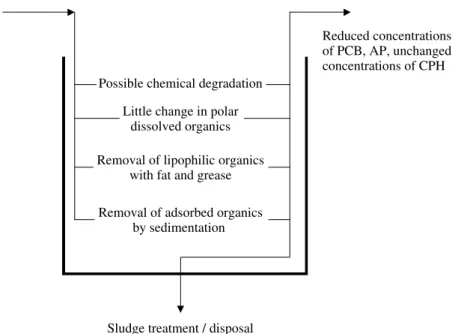
BEHAVIOR OF ENDOCRINE DISRUPTERS IN SEWAGE TREATMENT WORKS
- C HEMICAL D EGRADATION
Koc is the ratio between the concentration of the organic compound on organic carbon (mg g–1) and its concentration in water (mg l–1) at equilibrium; this can be estimated from log Kow values or solubility. The SRT at which maximum biodegradation occurs is a function of log Kow and the biotransformation rate of the compound. Biotransformation has more influence on compounds with log Kow in the range 1.5 to 4, such as estradiol with log Kow 3.94.34 Kow values also play a role in determining bioconcentration in the food chain.
FATE OF ENDOCRINE DISRUPTERS IN SEWAGE TREATMENT WORKS
- S URFACTANTS
- Triazine Herbicides
- Organochlorine Insecticides
- Chlorophenols
- O RGANIC O XYGEN C OMPOUNDS .1 Di-(2-ethyhexyl)phthalate
- Bisphenol A
- Polychlorinated Biphenyls
- Polyaromatic Hydrocarbons
- Polybrominated Flame Retardants
- O RGANO M ERCURY C OMPOUNDS
- C ASE S TUDY
Stoveland, S., Lester, J.N., and Perry, R., The influence of nitrilotriacetic acid on heavy metal transfer in the activated sludge process. Stoveland, S., Perry, R., and Lester, J.N., The influence of nitrilotriacetic acid on heavy metal transfer in the activated sludge process. Stephenson, T., Perry, R., and Lester, J.N., The influence of transients on the biodegradation of nitrilotriacetic acid in the activated sludge process.
INTRODUCTION
- C OMPOUNDS A SSOCIATED WITH S LUDGES
One of the most important factors determining the effectiveness of sludge treatment is the availability of the organic material for further degradation. In secondary sludge, much of the organic matter is contained in intact cells and is not readily available. One of the objectives of sludge pre-treatment is to release the organic material for further digestion by anaerobic bacteria.21 It is therefore also likely that such processes may have an impact on the availability of contaminants bound to sludge and their subsequent fate.
PREDIGESTION TREATMENT TECHNIQUES
- S LUDGE T HICKENING
However, in connection with the removal of estrogenic substances, these will affect their fate in terms of the efficiency of the water separation from the solid substances. Dewatering the raw sludge with the polyelectrolyte Zetag 94S before removing water with filter presses had no effect on the partitioning of the hydrophobic PCBs into the solids. However, if the compounds remain unchanged, even though they are in solution, they will likely be returned to the plant manager in recycled water.
SLUDGE STABILIZATION TECHNIQUES
- Chlorophenoxy Herbicides
- Chlorophenols and Chlorobenzenes
- Polychlorinated Biphenyls, Dioxins, and Difurans
- Alkylphenol Ethoxylates
- Polyaromatic Hydrocarbons
- Other Compounds Implicated as EDCs .1 Herbicides and Insecticides
- T HERMOPHILIC A EROBIC D IGESTION
- C OMPOSTING
The stability of 2,4-D can be related to the positioning of chlorine atoms in the ring structure. Halogenated derivatives can be formed during chlorine disinfection in the presence of bromide ion. In terms of degradation processes acting on resistant organic compounds, this process is likely to be similar to the activated sludge process; however, the higher temperatures involved will result in a different population of bacteria.
POSTDIGESTION TREATMENT
However, it is possible that as a result of the sludge treatment process, a range of degradation products will be formed which, if they are products of metabolic activity, are likely to be more soluble in water than the parent compounds. The effect of vacuum filtration after the addition of aluminum chlorohydrate as a coagulant on the fate of PCBs, DDE, and dieldrin indicates that the more water-soluble compounds (in this case, dieldrin) are more likely to be removed during final dewatering. Recycling the sludge-derived liquids back to the plant head will result in the next phase of aerobic treatment.
SLUDGE DISPOSAL OPTIONS AND THEIR IMPACT
- T HERMAL P ROCESSING OF S LUDGE
Meakins, N.C., Bubb, J.M., and Lester, J.N., The fate and behavior of organic micropollutants during wastewater treatment processes: a review, Int. Chau, YK, Zhang, SZ, and Maguire, RJ, Occurrence of butyltin species in sewage and sludge in Canada, Sci. Wilson, S.C., Alcock, R.E., Sewart, A.P., and Jones, K.C., Persistence of organic contaminants in sewage sludge-amended soil: a field experiment, J.
ENDOCRINE DISRUPTERS IN THE RECEIVING AQUATIC ENVIRONMENTAQUATIC ENVIRONMENT
- Partitioning and Transport
- Transformation Processes
- E FFECTS TO B IOTA IN R ECEIVING S URFACE W ATERS
- Bioavailability
The bioavailability of EDCs to benthic organisms and demersal fish results in endocrine-disrupting effects in the organism and bioaccumulation in the food chain. Most EDCs favor sorption to FIGURE 6.1 Sources of EDCs and some fate processes in the water column and sediment phase or receiving surface waters (= particles). Fish reproductive effluent downstream of effluent discharge has induced VTG production in males33.

